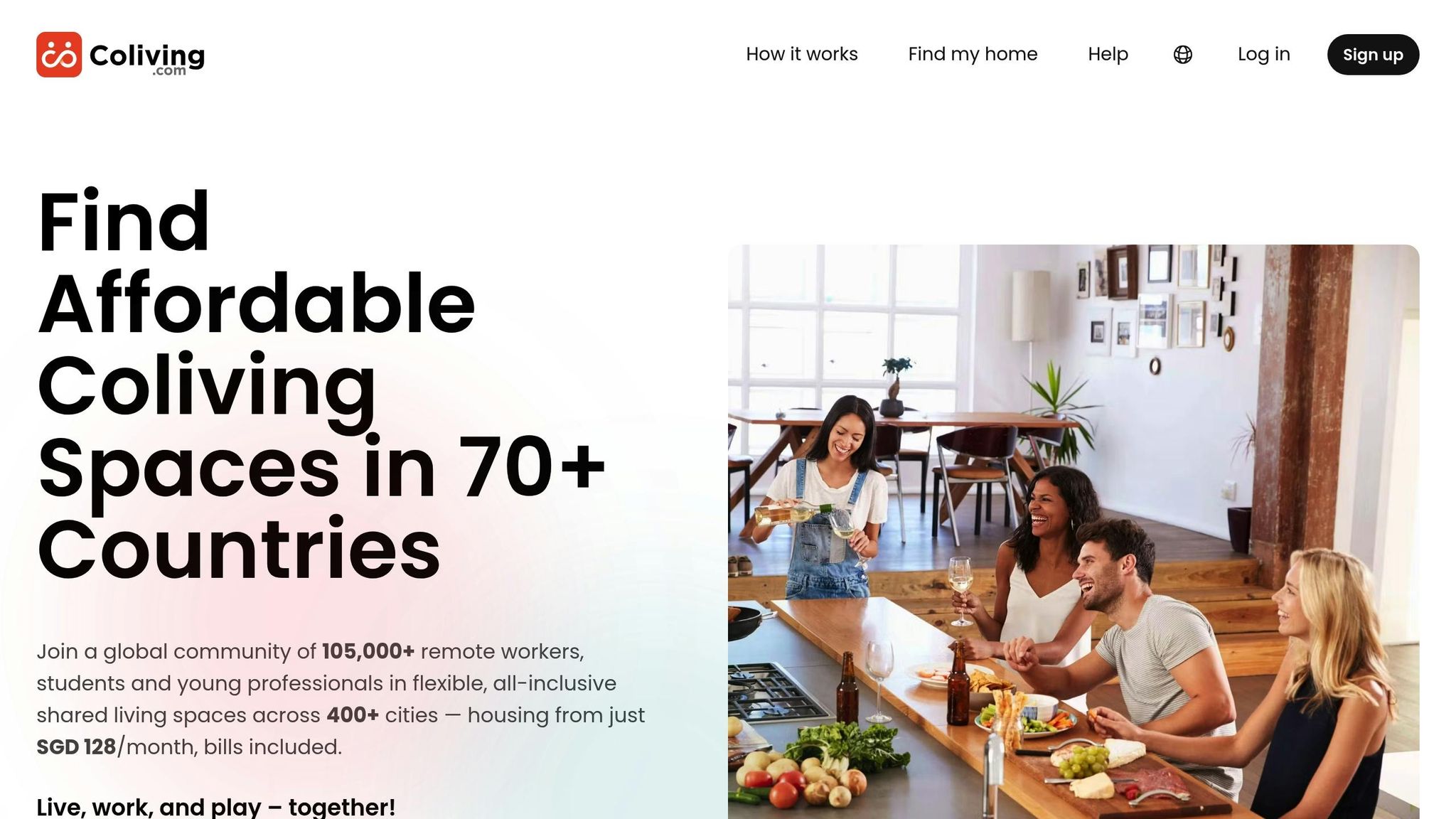Maintaining work-life balance in a coliving setup is challenging but achievable. Shared spaces and overlapping schedules can blur boundaries between work and personal life, leading to distractions, noise, and difficulty disconnecting. However, with clear routines, communication, and smart use of resources, coliving can support both productivity and well-being.
Key Takeaways:
- Challenges: Limited privacy, noise, distractions, and blurred boundaries between work and downtime.
- Solutions:
- Set clear work hours and boundaries.
- Use shared spaces like coworking areas for work and fitness rooms for breaks.
- Communicate with housemates about schedules and preferences.
- Use tools like Google Calendar and wellness apps to stay organized and reduce stress.
- Benefits: Built-in social connections, shared amenities, and cost-effective living.
While coliving requires compromises, it can foster a balanced lifestyle by combining community support with personal discipline.
Main Challenges to Work-Life Balance in Coliving
Coliving, while offering plenty of perks for remote workers and digital nomads, comes with its own set of challenges, especially when it comes to maintaining a healthy work-life balance. The shared nature of these spaces often blurs the lines between personal and professional life in ways that can be hard to navigate.
When Work and Personal Life Overlap
One of the biggest hurdles in coliving is that your bedroom often doubles as your office. Unlike a traditional home setup where you might have a separate space for work, coliving usually involves compact private rooms that have to serve multiple purposes. With your bed just a few steps away from your desk, it becomes tough to mentally separate work from relaxation.
Shared common areas add another layer of complexity. You might plan to work in the living room or kitchen, only to find someone else hosting a meeting or taking calls. Different schedules make it hard to establish shared routines, as one roommate might be starting their day at dawn while another wraps up their work late at night. This constant overlap can make it nearly impossible to create clear distinctions between work time and downtime.
The mental toll of this setup is real. When your workspace and living space are the same, your brain struggles to switch off from “work mode.” This can lead to overworking without realizing it or feeling guilty for relaxing in a space that’s also tied to productivity.
Coping with Noise and Distractions
Noise is one of the most common distractions in a shared living environment. Unlike living alone, where you control the atmosphere, coliving means dealing with unpredictable interruptions. Conversations in the kitchen, the sound of a blender during your client call, or someone’s video meeting in the next room can all disrupt your focus.
It’s not just about how loud things are - it’s about timing. You might be in the zone, working on something important, when someone decides to take a phone call nearby or start cooking. These interruptions can create a sense of anxiety as you never know when the next distraction will hit.
Clashing work styles add to the challenge. Some people thrive in a lively, bustling environment, while others require total silence to concentrate. In coliving, you’re constantly navigating these differences, often compromising your ideal working conditions. The person who needs quiet may feel frustrated, while someone who enjoys a more social atmosphere might feel stifled.
Balancing Social Interaction and Solitude
Coliving can leave you feeling caught between too much social interaction and a sense of isolation. On one hand, the constant presence of others can make you feel pressured to socialize, even when you’re craving alone time. After a long day of work, the last thing you might want is to make small talk in the kitchen, but avoiding shared spaces can make you seem distant or unfriendly.
Social events, while fun, can disrupt your schedule and drain your energy. Saying no to plans might feel uncomfortable when you’re living with the same people, but saying yes can throw off your workflow or leave you feeling exhausted.
On the flip side, despite being surrounded by people, you might still feel lonely. Surface-level interactions in shared spaces don’t always lead to meaningful connections. With roommates coming and going, working in different industries, and having varying social needs, it’s easy to feel disconnected.
Privacy becomes a rare commodity. Everyday tasks like making a private phone call or enjoying a quiet breakfast can feel complicated. This lack of personal space can leave you feeling like you’re always “on,” which can be mentally draining and make it harder to relax.
Timing also plays a role in social dynamics. You might be most social in the evenings, but your roommates are morning people - or vice versa. This mismatch can leave you feeling out of sync with the group, missing opportunities to connect when you’re actually in the mood for it.
Recognizing these challenges is an essential step toward finding balance in a coliving setup.
How to Achieve Work-Life Balance in Coliving
Living in a shared space can bring its own set of challenges, but finding a balance between work and personal life in a coliving setup is entirely possible. With thoughtful routines, smart use of shared amenities, and fostering healthy relationships with housemates, you can create a lifestyle that supports both your professional and personal needs.
Setting Up Routines and Boundaries
Establishing clear boundaries between work and personal time is key to maintaining balance. Start by creating a consistent work schedule and sticking to it. For example, if you work from 9:00 AM to 5:00 PM, make it a habit to shut down your laptop as soon as the clock hits 5:00 PM. This signals to your brain that the workday is over.
Visual cues can also help set expectations with housemates. Something as simple as a sticky note on your door - red for “do not disturb” and green for “available to chat” - can prevent interruptions and make your work hours more productive. Many remote workers find this approach reduces misunderstandings.
Another helpful tip is to develop a “shutdown ritual” to transition out of work mode. Whether it’s closing your laptop, changing into casual clothes, or taking a short walk, these small actions can mentally mark the end of your workday.
Communication is just as important. Discuss your work hours and noise preferences with housemates early on. For instance, let them know if you have important calls between 2:00 PM and 4:00 PM or if you need quiet mornings to focus. Setting these expectations upfront can prevent conflicts down the line.
Time-blocking is another game-changer in a shared living environment. Use your calendar to schedule not just work tasks but also personal time, meals, and social activities. This ensures you’re carving out time for yourself and not letting work take over your day.
Once your boundaries are in place, you can make the most of shared amenities to enhance your overall well-being.
Using Shared Spaces for Health and Wellness
Shared spaces in coliving communities can play a big role in maintaining your physical and mental health. Many coliving setups include fitness rooms, yoga areas, or outdoor spaces that can easily become part of your daily routine.
Start your day with a quick workout in the shared fitness room. Even a 20-minute session can boost your mood and focus, helping you transition smoothly from rest to work. Outdoor spaces like rooftops, gardens, or patios are also great for a mental reset. Taking a lunch break outside, even for just 15 minutes, can break up your day and prevent that cooped-up feeling.
Shared kitchens offer another opportunity to step away from work. Instead of eating at your desk, use cooking and meal times as natural breaks. Preparing and sharing meals with housemates can be both relaxing and a chance to connect socially without taking up too much time.
Wellness rooms or quiet spaces are perfect for decompressing. Whether it’s a quick meditation session, some light stretching, or just a few minutes of silence, scheduling these moments can recharge your energy. Even a 10-minute break can do wonders for your productivity and mood.
If your coliving space includes co-working areas, take advantage of them to separate your work life from your personal space. Moving to a different floor or common area for work can help your brain shift into “work mode,” leaving your bedroom as a dedicated place for relaxation.
Building Good Relationships with Housemates
Positive relationships with housemates can make or break your coliving experience. When you get along well with those you live with, it’s easier to set boundaries and maintain a harmonious environment.
Start small by engaging in casual morning interactions, like sharing coffee or a quick chat. These brief moments of connection can build trust, which comes in handy when you need to ask for quiet time or decline a social invitation.
Take an interest in your housemates’ schedules and work. Knowing when someone has a big deadline or an important meeting can help you offer support and expect the same in return. This mutual understanding fosters a sense of community while reducing potential conflicts.
As a group, consider setting informal guidelines for shared spaces. For example, you might agree on quiet mornings before 9:00 AM or designate weekday evenings as social hours. These agreements help manage expectations and create a balanced living environment.
Learning to say no respectfully is also important. If you’re invited to a movie night but have an early meeting, a simple “I’d love to join, but I have to get up early tomorrow” is much better than making excuses or avoiding the situation. Being honest and kind shows you value both your time and theirs.
To deepen connections without overwhelming your schedule, suggest structured social activities like weekly coffee chats or monthly group dinners. These planned interactions can fulfill your need for community while minimizing unplanned interruptions.
Finally, don’t shy away from addressing conflicts directly. Whether it’s about noise levels or shared space usage, a quick conversation can prevent small issues from snowballing into bigger problems. And remember, respecting others’ boundaries is just as important as setting your own. If a housemate seems busy or stressed, give them space - this kind of consideration often leads to mutual respect.
Tools and Resources for Coliving Residents
Living in a coliving space comes with its own set of challenges and opportunities, especially when it comes to balancing work and personal life. Thankfully, there are plenty of tools and resources available to help you stay productive, maintain your well-being, and make the most of your shared living experience.
Apps for Productivity and Focus
Staying organized and focused is crucial in a coliving setup, where shared spaces can sometimes blur the lines between work and relaxation. Here are some apps that can help:
- Google Calendar: Perfect for blocking out work hours, scheduling personal time, and even syncing calendars with housemates to avoid scheduling conflicts.
- Focus@Will: Offers background music specifically designed to enhance concentration, with different channels to suit your work style.
- Forest: A clever app that gamifies focus. Plant a virtual tree that grows during your work session - if you get distracted and leave the app, your tree withers.
- Slack: Great for coordinating household updates, sharing reminders, and keeping everyone on the same page.
- RescueTime: Tracks your device usage to help you understand where your time goes and make adjustments for better productivity.
These tools can help you stay on top of your tasks while ensuring smooth communication with housemates, making it easier to maintain a healthy work-life balance.
Community Features on Coliving.com

When it comes to simplifying the logistics of coliving, Coliving.com has you covered. The platform offers a seamless experience for finding and managing your living arrangements:
- 100% Online Process: From browsing listings to signing agreements, everything can be done online - no need for lengthy phone calls or in-person visits.
- Digital Rental Agreements: Review and sign all paperwork digitally, saving time and reducing stress.
- Flexible Cancellation Policies: If your circumstances change, you can easily adjust your plans without being tied down by long-term commitments. Plus, the money-back guarantee ensures peace of mind when moving into a new space.
- Extensive Options: With access to 38,000 rooms in 1,900 coliving spaces across 380 cities, you’re bound to find a setup that works for you. The standardized approach across 750 hosts means you can expect consistent quality and service no matter where you go.
These features make it easier to focus on your personal and professional goals without getting bogged down by housing logistics.
Wellness and Mental Health Resources
Your mental and physical well-being is just as important as your productivity, especially in a shared living environment. Here are some resources to help you stay healthy:
- BetterHelp and Talkspace: Online therapy platforms that let you connect with licensed therapists through text, phone, or video sessions - perfect for fitting therapy into a busy schedule.
- Headspace and Calm: Apps offering guided meditations, stress management tools, and sleep programs to help you unwind.
- Nike Training Club and Apple Fitness+: Provide workout routines you can do in your room or shared fitness areas, with sessions designed to fit into tight schedules.
- NAMI (National Alliance on Mental Illness): Offers free support groups and educational resources, including virtual sessions that can be especially helpful for those adjusting to communal living.
- Psychology Today’s Therapist Directory: A handy tool for finding local mental health professionals who accept your insurance and specialize in areas like stress management.
- Insight Timer: A mindfulness app with free guided meditations and silent meditation tools to help you manage stress effectively.
These wellness tools and services can make a big difference in maintaining your health and happiness while living in a shared space. By incorporating them into your routine, you’ll be better equipped to handle the unique dynamics of coliving.
Coliving vs. Living Alone: Work-Life Balance Comparison
Choosing between coliving and living alone can significantly shape your work-life balance, influencing everything from productivity to social interactions. Each option comes with its own set of perks and challenges, and understanding these differences can help you make the best decision for your lifestyle.
Coliving often provides a built-in support system, making it easier to navigate busy times. On the other hand, living alone means you’ll need to put in extra effort to create and maintain your personal network of support. This difference can directly impact how you balance work and personal life.
Flexibility is another key factor. Coliving spaces are usually move-in ready, with furnished rooms and utilities included, making transitions smoother - perfect if you’re chasing new opportunities. Living alone, however, gives you the freedom to fully customize your space, though it does require more upfront planning and effort.
Privacy is where living alone truly stands out. It offers complete control over your environment, which is ideal for focused work or private calls. In contrast, coliving requires balancing shared spaces with personal time. While common areas can occasionally disrupt your workflow, they also provide natural breaks that might help prevent burnout.
Here’s a quick comparison of the main aspects of coliving and living alone:
| Aspect | Coliving | Living Alone |
|---|---|---|
| Community Support | Built-in emotional and practical support | Requires effort to establish and maintain a support network |
| Flexibility | Furnished spaces with utilities included for easy transitions | Full freedom to customize, with more upfront planning needed |
| Privacy | Shared spaces may limit privacy during work hours | Full control over your environment for work and relaxation |
| Amenities | Access to shared spaces and services | Must independently arrange amenities and services |
| Cost Considerations | Shared expenses, including utilities and some services | Individual budgeting for all costs |
| Work Distractions | Social settings can provide both breaks and distractions | Minimal interruptions, but requires self-discipline to stay balanced |
| Networking | Built-in opportunities to meet diverse people | Networking requires intentional effort |
| Mental Health | Regular social interaction can reduce loneliness | Solitude offers control over social engagement, which can be positive or challenging based on personal needs |
Ultimately, the choice between coliving and living alone comes down to your personal preferences and work style. Whether you thrive in a community or prefer the peace of solitude, aligning your environment with your priorities is key to maintaining a healthy work-life balance.
Conclusion: Making Work-Life Balance Work in Coliving
Finding work-life balance in a coliving setup is absolutely achievable with the right approach. It’s about recognizing the unique dynamics of shared living and taking proactive steps to make the most of its opportunities while addressing its challenges.
Tips for Coliving Residents
Work-life balance in coliving revolves around three key practices: setting boundaries, fostering open communication, and making smart use of available tools and resources.
- Setting boundaries: Establish clear work hours, use signs or signals to indicate when you’re unavailable, and respect others’ personal time and space. Boundaries create a sense of structure and mutual respect in shared environments.
- Effective communication: Regular house meetings, shared calendars, and honest conversations about noise or shared space usage can prevent misunderstandings. Open communication not only resolves potential conflicts but can also lead to stronger support systems among housemates.
- Using resources wisely: Take advantage of productivity tools, wellness apps, and the built-in social network of coliving. These resources help you transition smoothly between work and downtime, while the community aspect of coliving offers built-in social connections without extra effort.
These practices not only help you maintain balance but also allow you to fully embrace the benefits that coliving offers.
How to Make Coliving Work for You
Coliving isn’t just about shared spaces - it’s a lifestyle that can enhance both your professional and personal life. With flexible living arrangements and utilities included, coliving eliminates many of the traditional hassles of housing, freeing you to focus on what really matters: building routines and relationships.
Success in coliving comes down to blending the collective spirit of shared living with your individual priorities. By setting clear boundaries, communicating openly, and using resources thoughtfully, you can turn potential challenges into stepping stones for a more balanced and fulfilling life. Coliving becomes more than just a place to live - it’s a way to thrive in both your career and personal growth.
FAQs
How can I set clear boundaries in a coliving space to balance work and personal life?
Maintaining a healthy work-life balance in a coliving space starts with setting some clear boundaries. One great way to do this is by designating a specific workspace within your living area. This physical separation makes it easier to mentally shift gears between work and relaxation.
Another key step is to stick to a consistent daily routine. Set regular work hours and make time for breaks to prevent burnout. Let your housemates know your schedule so they can avoid interrupting you during focused work sessions. Small habits, like changing the lighting or playing a certain playlist, can also help signal when you’re transitioning between work and downtime.
Finally, open communication is essential. Respect shared spaces and talk openly with housemates to ensure everyone feels comfortable. With a mix of structure and flexibility, you can stay productive while building strong connections within your coliving community.
How can I reduce noise and distractions while working in a shared living space?
To cut down on noise and distractions in a shared living space, start by setting up a dedicated workspace in a quieter spot, preferably away from areas with a lot of foot traffic. A pair of noise-canceling headphones can work wonders for drowning out background noise and keeping your focus sharp.
You might also want to add sound-dampening elements like rugs, curtains, or even partitions to help lower noise levels. On top of that, having a conversation with your housemates to agree on quiet hours or ground rules for shared spaces can make a big difference. Even small tweaks, like facing your desk toward a wall or moving it away from busy areas, can help you stay focused and productive.
How can I build meaningful connections with housemates while maintaining personal space?
Building strong connections with housemates while keeping your personal space intact requires a thoughtful approach. Begin by having honest conversations to establish boundaries that everyone respects. This creates a home environment where socializing feels natural, yet personal limits are honored.
Engage in shared experiences like cooking a meal together, hosting a movie night, or attending local events as a group. These activities provide opportunities to bond without forcing interaction. At the same time, carve out time for yourself - whether it’s relaxing in your room or indulging in a hobby you enjoy solo. Striking this balance between togetherness and personal time helps nurture meaningful relationships while maintaining your sense of independence.






